Assam, eastern state of Indian Subcontinent is jam-packed with diversities and colors, also reflects in the array of fairs and festivals, which are feted by different tribal communities all across Assam. The fairs and festivals of Assam are the only source of entertainment to their tough and rigid lifestyle that they go through. The fusion of the ancient heritage, rich glory and spirituality of sub tribes and tribes, has made this land dwelling place of many colorful and adorable festivals, which are filled with mesmerizing, passion, and compelling that also reflects the spirit, lifestyle, and tradition of the Assamese people. The only aims of celebrating these festivals are to bind all the religion and Cultures together. A spirit of togetherness and accommodation typifies the fiesta.
The Religious Fairs and Festivals Celebrated by the Assamese Include:
Bihu Dance Festival, Bash festival, Siami, Heleibambe, Ali Ai Ligang, Nyada, Pi-Pe, Bohaggiyo etc.
The festivals are known for their own majestic influences and also for their once in a while.
Ali Ai Ligang
Fast Facts:
- Situated: Assam, India
- Celebrated By: (Mishing Tribe)
- Month of the Festival: February-March
- Implications: Sowing of the Paddy begins on this particular day
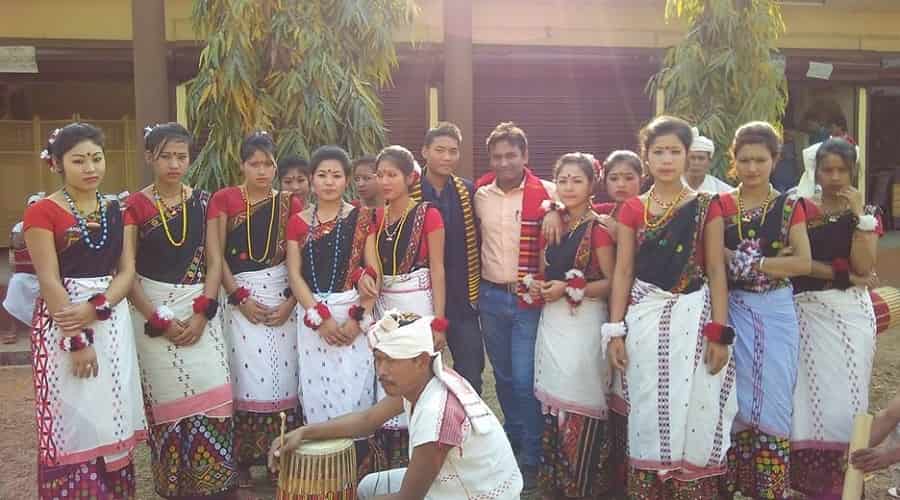
The spring falls to revitalize life again. The festival of Ali Ai Ligang is a spring festival celebrated by the Mishing Tribe. Ali Al Ligang is a very colorful festival held annually on the 1st Wednesday known as Ligang Lange in the Assamese language, of the months of (February-March). The meaning of Ali is roots and seeds and the meaning of Ligang is sow. Therefore, sowing of the paddy seeds starts on the same day.
The Celebration
Dance Performances are conducted by all the young girls and boys. Some of the special characteristics of this type of dancing include fapping, brisk stepping and flinging of hands, which reflects passion of the youths, enjoyment and reproductive urge. Dried Fish, Rice beer also known as Poro Apong is required for the lavish feast.
The festival is on for 5days and during this colorful festival certain rituals, which are observed as Taboo in the country, like fishing, burning jungles, ploughing and cutting down the trees are compulsorily observed.
Bash Puja
Fast Facts :
- Situated : Assam, India
- Commenced By : Hajongs
- Festival Dance : Bamboo Dance of Hmar
- Duration: Three Days
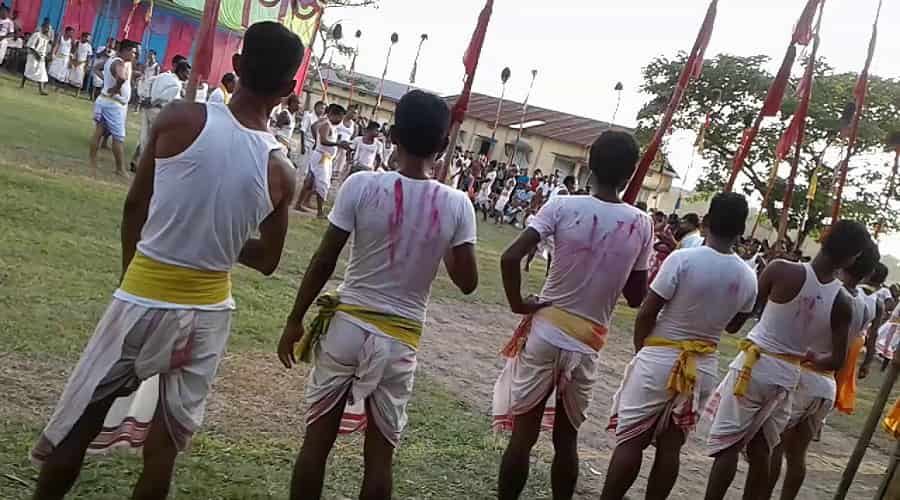
Bash Puja is nothing but the idolizing of bamboo and is 1 of the most important spiritual rites carried out by the Tribal communities of Hajongs. This Puja is performed in the holy month of Baisag, which is the 1st month of Assamese. 3 lately cut bamboos pieces are used for the feat of the Bash Puja that is carried on for 3 days. Groups of villagers slash the 3 bamboos planks from a meticulous grove. After beautifying them with red or white cloths the planks of the bamboos are set on the land and then idolized.
The Deities:
The 2 major bamboos symbolize 2 Gods. Nevertheless, at present there are different views about the 2 Gods. Accordingly the 2 Bamboos symbolizes Gopal and Madan and the other group believes that the 2 Bamboos symbolizes Parvati and Shiva and again this changes according to few scholars as they believe the Bamboos represents Indra God and also the Sex God ( Madan Kamdev and Rati, his partner).
Heleibambe
Fast Facts:
- Situated: Assam, India
- Feted By: Zemi Naga
- Dance of the Festival: Naga Dance performed by the Zemi
- Time of the Festival: Middle of April
Time for Festivity:
The festival of Heleibambe is feted by the Zemi Village. The villagers commence this festival before the cultivation of Jhum in the middle of April. Few rituals are performed by the priest of the village known as Tingkupeu like the one sacrificing of Buffalo for the sake of betterment of crops. The meat is then distributed amongst all the villagers.
The Rituals:
After the lavish feast is done, all the members of Leuseuki and Hengseuki starts singing and dancing which goes on for the entire night. On the 2nd day, all the young girls and boys dance and sing in the streets of village halting in front of the entire household.
The main reason of commencing this festival is to assuage Suhprai, the crop god, so that they get bountiful of good cropping.
Nyada
Fast Facts :
- Situated : Assam, India
- Feted By : Rengma Nagas
- Month of the Festival : December
- Duration : Eight days
The festival Nyada is commenced in the month of (December) Penepho, Rengma Nagas. This festivals marks the conclusion of the agricultural year. This festival goes on for 8 days and also has many implications.
The Rituals:
On the very 1st day of the festival, rice beer is imbued. On the 2nd day, graves of all the ancestors are cleaned by their family members and the stone slabs are also changed. On the 3rd day, rice beer is offered by women’s to the graves. On the 4th day, young girls and boys dance and sing in the fond memory of their ancestors. The young crowd also collects varieties of foodstuffs from all the villagers. The 6th day, the major festivity starts with the consumption of rice beer with all the villagers. On the 7th day, the villagers repair their individual house. On the final day of the occasion young men arranges a gathering and feast.
Rongker And Chomangkan
Fast Facts :
- Situated : (Karbi Anglong), Assam, India
- Feted By : Karbi Tribe
- Implication of Rongker : Well-being of the humankind and Good Harvest
- Implication of Chomangkan : Death Ceremony.
Lusty green high mountains, giggling springs, sweet voice of the Cuckoos and sweet fragrance of the flowers takes you to the dwelling place of the Karbis, who had drifted to this land several years ago. Karbi People are known to be peace lovers.
Unusual Characteristics of the (Karbi Fiesta) :
Rongker and Chomangkan are 2 major festivals celebrated by the Tribes of Karbi. Rongker is especially a spring festival and is commenced at the starting of New Year. This festival is prearranged by the elders of the tribe to appease different goddesses and gods for the happiness of all. They also pray for good harvest. The rituals also say that the women’s should not enter the temple premises.
On the other side, Chomangkan Festival is fully devoted to the dead people. This festival is a very important for the tribes of Karbi and is on for 4days and 4 nights.
Bohaggiyo Bhishu
Fast Facts :
- Situated: Assam, India
- Celebrated by: The tribal group of Deoris
- Month of the Festival: April
- Major Attraction: Carol Song or Husori Party and Deodhani Dance
Bohaggiyo Bishu is spring festivals celebrated by Deoris and are believed to be a part of the Chutiyas Race. It is said that the term of Bishu was taken from Chutiya where (“Bi”) means extreme and (“Su”) means rejoicing.
Celebration for a Week:
The spring festival of Bohaggiyo Bhishu is celebrated in the month of April and commences for 7 days with unhindered merry making and joy. This festival is started by a Puja called as Than Puja, which precede on Wednesday.
The Rituals:
Before the Than Puja, many arrangements and socio religious implications are made. The rituals include, forfeit of a white Buffalo in every 4 years, which is a substitute for human sacrifice that was practiced before. The most significant element of the Bohaggiyo Bhishu festival is the Deodhani Dance and the carol song or Husori. Sibsagar, Nagaon, Dibrugarh and Lakhimpur some of the major point of attractions.
Jonbeel Mela
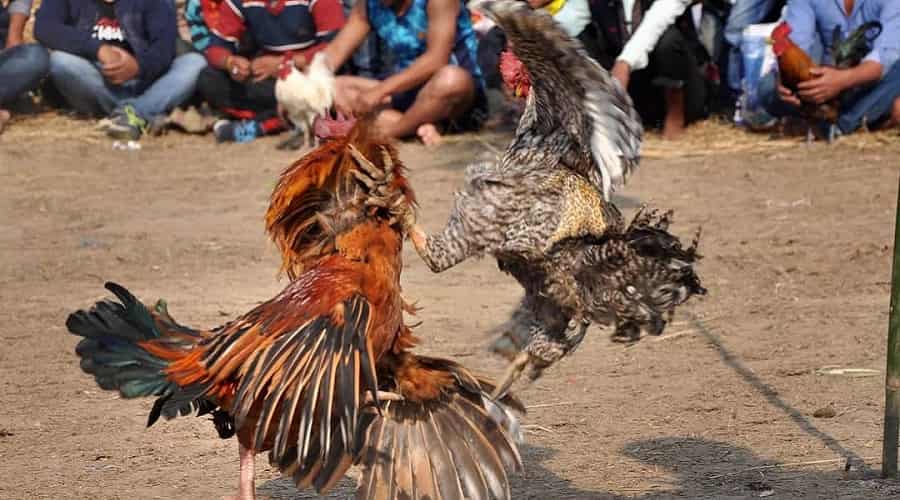
Fast Facts:
- Situated: Jonbeel, Jagiroad (32kms away from Guwahati), Assam, India
- Major Ritual: Agni Puja
- Implication: Celebration of unity and Harmony
Jonbeel Mela is annually celebrated during the winter season at Jonbeel, Jagiroad, a town close to Guwahati, approximately 32kms away from this city. This exotic Mela is swarms to be the popular and spectacular fairs of the state.
Just before the commencement of this Mela, all the communities and tribes like Jaintia, Tiwa, Khasi, and Karbi from the Northeastern Part of Assam comes down with all their selling products. On the eve of this Mela, a very big bazaar or market is organized where all the tribes and communities swap their products. This is a unique scene in the civilized society of today.
The Rituals:
Agni Puja is performed which signifies the betterment of humanity. One of the unique features of the Jonbeel Mela is that the king also known as Gova Raja of the Tribes of Tiwa visits this place along with all his courtiers and collects taxes as a part of the ritual.
The implication of the Jonbeel Mela is unity and harmony among all the communities and tribes. Throughout the Mela, these communities and tribes perform their local music and dance and celebrate this event in a pompous manner.
Pi-Pe
Fast Facts :
- Situated: Assam, India
- Feted By: Rengma Naga
- Month of the Festival: January
- Duration: Three days
Pi-Pe Festival is pompously feted by Rengma Naga, in the starting of the January also called as Thui. This festival commences for 3 days and the chief purpose for this festival is to stay away from all the bad evils for the rest of the year.
Rituals:
During the festival, which commences for 3days, people wear new clothes and also keep their surroundings as well as house clean. The main rituals say that the married couples should not encompass any sexual contacts for 3 days at all. After observing this ceremony, Jhum crops are grown, thus marking the end of Pi-Pe.
Siami
Fast Facts :
- Situated: Northern Cachar Hills, Assam, India
- Feted By : Zemi Nagas
- Implication: Harvest Festival
- Duration: Four Days
It is a Harvesting festival observed by the Nagas of Zemi, Northern Cachar Hills. This festival is prearranged by all the young girls and boys of the tribes.
The Celebration:
As the Festival of Bihu commences in the neighboring Dimasa Kacharis, this festival is also a youth oriented festival. The lavish feast comprises of meats, rice beer and many other relishing foodstuffs. The Siami Festival ends with their traditional music and dance performed by the young girls and boys. The earnings of Morungs are utilized in the setup of the event.
Traditional Rituals:
This festival usually goes on for 4 days. Brewing of the exotic rice beer is intaked by all the members of the family. The clothes, which all the Morung Boys wear, are made by the girls and these clothes are worn by them for 3days and 3 nights.
Interesting Features:
The interesting phenomena of this festival is the competition which is held between the young girls and boys to summarize the names of creepers, medicinal plants, flowers, orchids, etc. This is done to educate the tribal masses.
Baikho
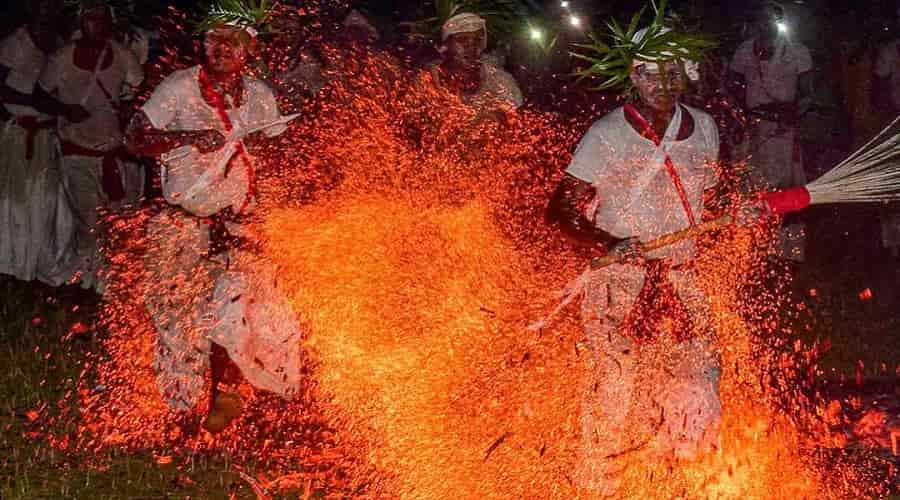
Fast Facts:
- Feted By: The Rabha Tribe
- Major Dance of the Festival: Rabha Dance
- Implication: Devoted to the Almighty of Wealth
The Tribal Community of Rabha does not have any festival of their own like the other groups. Baikho is a spring festival celebrated and popularly called as Khoksi Puja or Baikho to appease the almighty God of Wealth, ”Baikho”. As this is a tribal Festival, it is not much popular in other parts of Assam.
Dosa Thoi Long Nai
Fast Facts:
- Situated: Assam, India
- Presented In: The eve of Bathow Puja
- Month of the Festival: April
Dosa Thoi Long Nai is one of the significant sacred dances presented at the Puja of Bathow where the adoration of Lord Shiva takes place. The dance performance includes Deodhani Dance performed by the youths of Assam with a small bowl on their head which is full of blood of the fowl.
The Legends:
It is said that while all the Deodhani Dancers performs this dance, Lord Shiva comes down and imbibes the blood.
Khong Kepang Kennyu
Fast Facts:
- Situated: Assam, India
- Implication: Ceremony linked with 1st harvesting of Paddy
Harvest Festival:
The ceremony links with harvesting of ripening paddy and is known as Khong Kepang Kennyu.This festival is a very important ceremonies linked with agriculture. Khong Kepang Kennyu is so important that without observing this sacred ceremony, no harvesting takes place.
The Rituals:
The oldest woman of the village goes to paddy field and the harvesting of rice is done at the dawn. She also carries rice beer and food with her and offers the same to all the spirits of the rice crops. After all the ritual is over, she eats the cooked rice and finally after this last ritual, villagers start reaping paddy.
Rajni Gabra and Harni Gabra
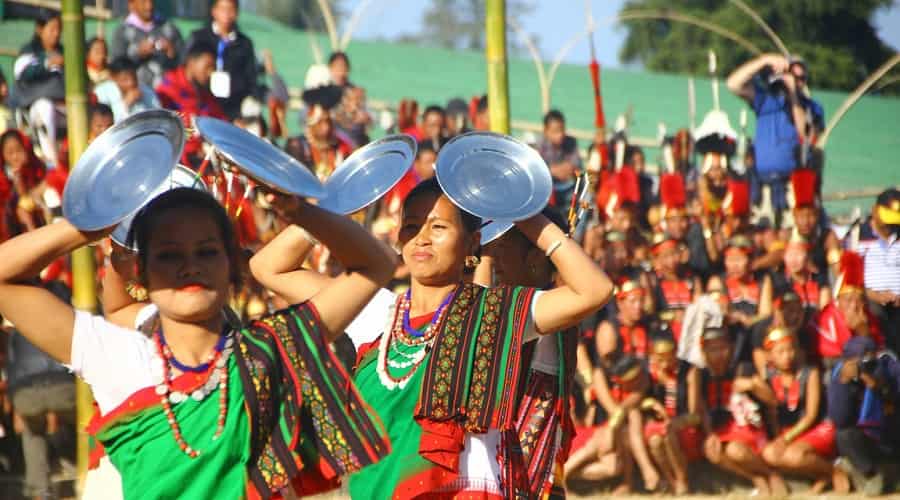
Fast Facts:
- Situated: Assam, India
- Feted By: Dimasa Tribe
- Dance of the Festival: Dimasa Dance
- Implication: Commenced before starting of brand new season of cultivation.
Rajni Gabra and Harni Gabra are the yearly festivals, celebrated by the Dimasa Tribes. This is especially a social and religious festival that marks its beginning before the cultivation of any new crops.
Rituals:
This festival is feted mostly in the morning time. The headman of the village also known as Kunang appeases family idol by shutting the gate of the village on the eve of the Puja. Harni Gabra is conducted on the same night. The village idol is adored for the welfare and protection of all the villagers.
Peculiarity:
There is a unique peculiarity observed as during process of this festival, inspite of the gates of the village being closed, if any outsiders enter the village, it is thought to be inauspicious and the culprit is strictly observed to bear all the cost for spoiling the festival.
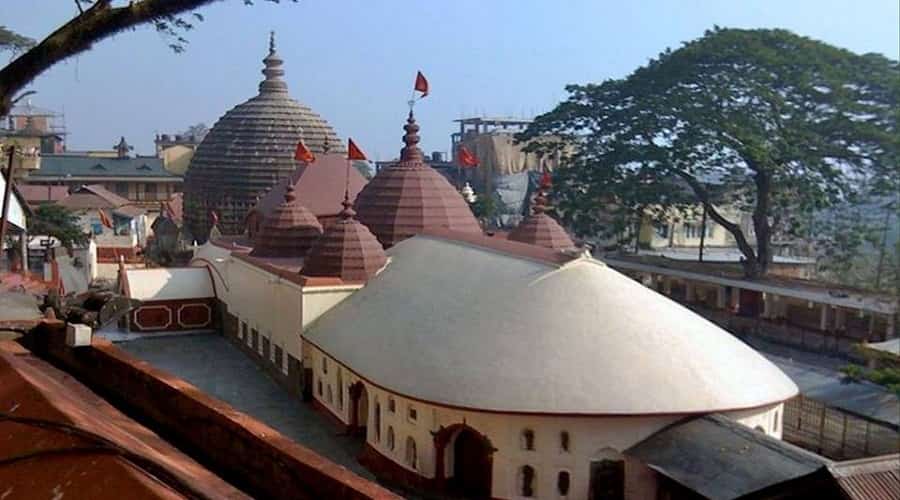
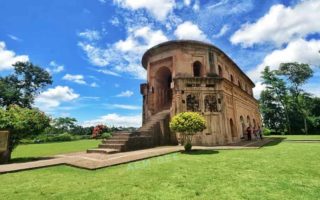
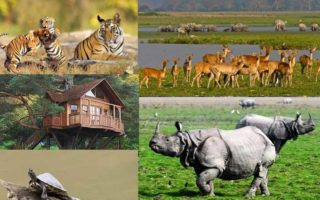
Woow how cool they look in their traditional attire. I always love to discover Ethinic People of North east India.